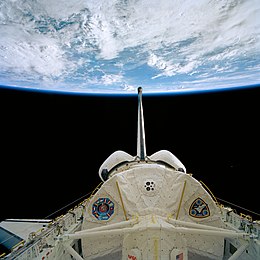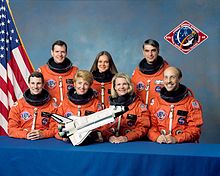STS-40

View of Columbia's payload bay showing Spacelab
|
|
| Mission type | Biosciences |
|---|---|
| Operator | NASA |
| COSPAR ID | 1991-040A |
| SATCAT no. | 21399 |
| Mission duration | 9 days, 2 hours, 14 minutes, 20 seconds |
| Distance travelled | 6,083,223 kilometers (3,779,940 mi) |
| Orbits completed | 146 |
| Spacecraft properties | |
| Spacecraft | Space Shuttle Columbia |
| Landing mass | 102,283 kilograms (225,495 lb) |
| Payload mass | 12,374 kilograms (27,280 lb) |
| Crew | |
| Crew size | 7 |
| Members |
Bryan D. O'Connor Sidney M. Gutierrez James P. Bagian Tamara E. Jernigan M. Rhea Seddon F. Drew Gaffney Millie Hughes-Fulford |
| Start of mission | |
| Launch date | 5 June 1991, 13:24:51 UTC |
| Launch site | Kennedy LC-39B |
| End of mission | |
| Landing date | 14 June 1991, 15:39:11 UTC |
| Landing site | Edwards Runway 22 |
| Orbital parameters | |
| Reference system | Geocentric |
| Regime | Low Earth |
| Perigee | 287 kilometres (178 mi) |
| Apogee | 296 kilometres (184 mi) |
| Inclination | 39.0 degrees |
| Period | 90.4 min |
 Left to right - front row: Gaffney, Fulford, Seddon, Bagian; Back row: O'Connor, Jernigan, Gutierrez |
|
STS-40, the eleventh launch of Space Shuttle Columbia, was a nine-day mission in June, 1991. It carried the Spacelab module for Spacelab Life Sciences 1 (SLS-1), the fifth Spacelab mission and the first dedicated solely to biology. STS-40 was the first spaceflight that included three women crew members.
Launch originally set for 22 May 1991. Mission postponed less than 48 hours before launch when it became known that a leaking liquid hydrogen transducer in orbiter main propulsion system which was removed and replaced during leak testing in 1990, had failed an analysis by vendor. Engineers feared that one or more of the nine liquid hydrogen and liquid oxygen transducers protruding into fuel and oxidizer lines could break off and be ingested by the engine turbopumps, causing engine failure.
In addition, one of orbiter five general purpose computers failed completely, along with one of the multiplexer demultiplexers that control orbiter hydraulics ordinance and orbiter maneuvering system / reaction control system functions in the aft compartment.
A new general purpose computer and multiplexer demultiplexer were installed and tested. One liquid hydrogen and two liquid oxygen transducers were replaced upstream in propellant flow system near the 17-inch (43 cm) disconnect area, which is protected by internal screen. Three liquid oxygen transducers replaced at engine manifold area, while three liquid hydrogen transducers here were removed and openings plugged. Launch reset for 8 am EDT, 1 June, but postponed again after several attempts to calibrate inertial measurement unit 2 failed. Unit was replaced and retested, and launch was rescheduled for 5 June. Launched successfully on 5 June 1991, at 9:24:51 am EDT., the mission had a launch Weight: 114,290 kilograms (251,970 lb).
It was the fifth dedicated Spacelab mission, Spacelab Life Sciences-1, and first dedicated solely to life sciences, using the habitable module. Mission featured most detailed and interrelated physiological measurements in space since 1973–1974 Skylab missions. Subjects were humans, 30 rodents and thousands of tiny jellyfish. Primary SLS-1 experiments studied six body systems; of 18 investigations, ten involved humans, seven involved rodents, and one used jellyfish.
...
Wikipedia

